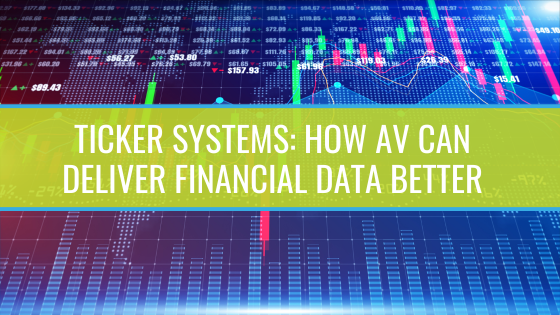Ticker systems have been around for more than a century, and today’s version of the technology still serves the same purpose - monitor high volumes of data. We’ve come a long way since the ticker tape days of the early 20th century, though, as current ticker systems are powered by modern AV tech.
This includes LED displays that can be shaped and sized endlessly. With this flexibility, ticker systems can be effectively integrated into any space.
What are Ticker Systems Used For?
Ticker systems have long been used to relay data from financial markets. Traditionally, this has mostly involved NYSE or AMEX-listed companies, but there are tens of thousands of assets that can be tracked in this way. This financial information is of particular value to brokerage firms and banks, but you’ll find ticker systems in places you wouldn’t expect. Universities, business schools, sports stadiums, hospitals, and airports are some examples. Modern ticker systems can deliver more than financial data, too. They can also display news headlines, weather forecasts and sports scores, among other information. A ticker system’s multifunctionality means the technology can be placed wherever people are catching up on current events.Ticker Systems are Also Found in Retail Settings
Although LED tickers are still predominantly used for financial data, many retail brands are utilizing the technology to deliver on-brand messaging. Install the ticker in a window display and attract people with color and motion. Place tickers high up and around the room’s perimeter, and it can be used to advertise product specials. Ticker systems can even be scaled down to fit in individual product displays, where they can provide additional information for customers - like price, model or intended application.Ticker System Displays Can Be Customized for a Variety of Spaces
The vast majority of ticker systems, though, are still intended for financial institutions. Here, they provide instant information for traders to pull from. AV has modernized the way ticker systems operate. Here’s how the industry is making better ticker systems:- Leveraging reliable LED engineering - Given the critical nature of real-time financial data, your ticker systems cannot fail. That happens to be a major advantage of LEDs. LED technology is valued for its reliability and longevity, and you can expect several years of performance from your LED tickers. Also, LEDs age gracefully, so even as they near the end of their rated life, they still provide like-new visual performance.
- Using vivid, high-contrast displays - LED displays offer superior color contrast and brightness, so they’re easily read from a distance. As many brokerage offices are arranged in an open-floor design, this improved visibility will help your traders make better, faster decisions.
- Adapting ticker displays for a wider range of settings - A major breakthrough with LED displays is their flexibility. LED tickers offer a modular-like design, so they can be scaled up or down in size as needed. LED tickers can also be shaped to bend around sharp corners or into curves, so any interior space can accommodate one.
- Supplementing ticker systems with additional AV - And if a lone ticker isn’t enough, additional displays can be attached to the system and used to provide additional information. There’s only so much data a ticker can output - additional display space will provide even more for your firm.
In control room settings, where an entire wall may be available for displays, an AV integrator can install oversized displays or video walls for maximum visibility.
As you can see, modern ticker systems have leveraged the best of AV design practices. To ensure your ticker displays are properly designed and installed, though, consider working with a certified AV integrator.A Certified AV Integrator Can Maximize Your Ticker System’s Effectiveness
As simple as ticker systems appear to be, there are several things to consider before setting one up. For example:- How will the ticker system be powered? - Ticker systems are installed in sections and snap together for streamlined placement. Each section is also designed to carry power and data to the next, but it’s not always easy determining where cable should be run. This can be a big challenge for systems that aren’t wall-mounted but suspended from the ceiling instead.
Certified integrators are cable-pulling experts and will ensure no power or data cable is exposed following installation.
- Can your ticker system provide all the information you need? - An integrator will also match your data-delivering needs to the best possible solution. If a ticker alone won’t get the job done, an integrator can customize your solution with additional display hardware and ensure it is configured to output the data you’re looking for.
- Can the ticker system be comfortably seen by those who need to see it? - A common mistake when installing displays is placing them in a spot where people aren’t looking. If your tickers are elevated off the ground too high, placed at suboptimal angles or not properly sized for the room, they may blend into the background instead of standing out.
AV integrators know ideal display placement and positioning, so they can account for where your audience will be.
- Do you have a plan in case maintenance is needed? - Ticker displays require minimal maintenance for reliable operation, but a back-up plan is recommended for any technology. Downtime is expensive, which is why many organizations opt for extended support through their AV integrator partner.



